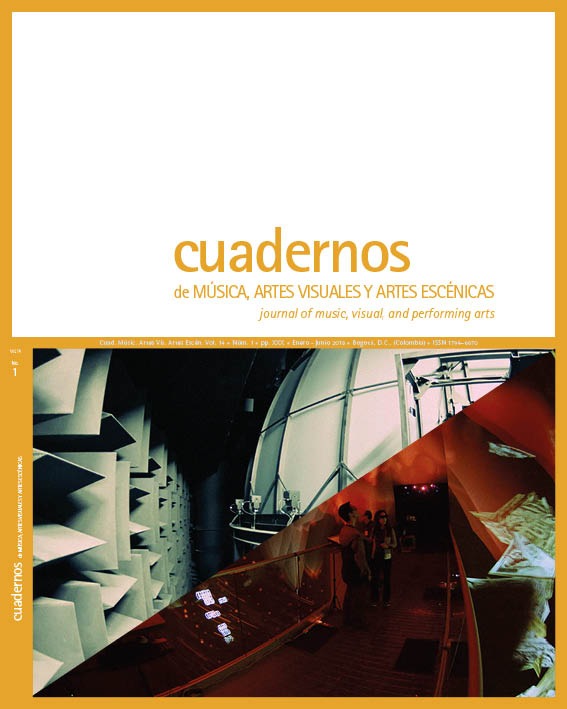Space in sound installation
##plugins.themes.bootstrap3.article.details##
The purpose of this article is to expose the space as one of the main artistic concerns in the sound installation from different points of view (artistic, aesthetic and philosophical). The spatial thought of the philosophical work Esferas, by Peter Sloterdijk, is taken as a basis for reflection, whose fundamental proposal is that life is a question of form, that any space imagined and created by humanity manifests a way of doing and being, and it is in that place where the essence of mankind can be understood. The works of diverse artists, whose work has been developed to a large extent in the form of this practice, are analyzed in order to treat the experience of space from the sound creation. Among them are Max Neuhaus, Robin Minard and Céleste Boursier-Mougenot. Finally, a connection is interwoven between the works analyzed and various qualities of Sloterdijk’s spatial thinking to expose them as spaces of creation that reveal a way of relating to the environment through what is heard. What is heard and how it is shared are innate questions to the experimentation of this artistic form, hence the importance of the immersion, the listening, the journey. From this point of view, the analyzed works are understood as territories that interrogate artistic and aesthetic listening, an activity with a dynamism that transforms, interrogates and redeems the spaces of life.
sound installation, immersion, listening territory, phonotope, phonosphereinstalação sonora, imersão, território de escuta, fonotipo, fonosferainstalación sonora, inmersión, territorio de escucha, fonotipo, fonoesferasound installation, immersion, listening territory, phonotope, phonosphere
Distributed Art Pub Inc.
Boursier-Mougenot, Céleste. 2002. “Entrevista con Camille Labro”. Magazin Beaux-arts (213): 54.
— 2008. États seconds. Arlès: Analogues.
Foucault, Michel. 2009. Le corps utopique, les hétérotopies. París: Nouvelles Éditions Lignes.
Kihm, Christophe. 2008. “Ajustements: entretien de Christophe Kihm avec François Quintin”. En États
seconds, de Céleste Boursier-Mougenot, 22-75. Arles: Analogues.
“Klangstille”. 1995. “Klangstille” (sala de lectura de la Universidad Técnica de Berlín TU). 1995. Niko
Catania. http://www.robinminard.com/minard.content.php?id=40&sh=0Minard, Robin. 1996. Sound
Installation Art. Graz: Editeur Institut für Elektronische Musik.
Neuhaus, Max. 1995. Evoquer l’auditif. Niza: Editorial Charta/Museo de Arte Contemporáneo Villa Arson.
— 1998. “Max Neuhaus from a conversation with Michael Tarantino”. Two Passages. http://www.
maxneuhaus.info/soundworks/vectors/passage/twopassages/
— 1999. “Mysterious Noises on 46th Street | Times Square New York City”. http://adam.curry.com/
art/1376408041_QPUL9BYF.html.
Regnauld, Hervé. 2011. “Le concept de tout est une forme: la pensée spatiale de Peter Sloterdijk”.
EspacesTemps.net. https://www.espacestemps.net/articles/le-concept-de-tout-est-une-forme-lapensee-
spatiale-de-peter-sloterdijk/
Roberts, Lynda. 2017. “NYC, Listening to Max Neuhaus’s Times Square”. Flickr. https://www.flickr.com/
photos/publicassembly/37410284151
Schulz, Bernd. 2003. “Form and Function in the Sound art of Robin Minard”. En Silent Music: Between
Sound art and Acoustic Design, de Robin Minard. Heidelberg: Kehrer Verlag.
Sloterdijk, Peter. 1987. Critique de la raison cynique. París: Christian Bourgois.
— 2001. Extrañamiento del mundo. Valencia: Pre-Textos.
— 2002. Sphères I, Bulles. París: Hachette.
— 2006. Esferas III. Madrid: Siruela.
Szendy, Peter. 2001. Écoute: une histoire de nos oreilles. París: Minuit.
— 2015. En lo profundo de un oído: una estética de la escucha. Santiago de Chile: Metales Pesados.
Vásquez Rocca, Adolfo. 2008. Peter Sloterdijk: esferas, helada cósmica y políticas de climatización.
Valencia: Institució Alfons el Magnànim/Diputación de Valencia.
Wuillème, Tanguy. 2002. “Peter Szendy, Écoute. Une histoire de nos oreilles, précédé de
Ascoltando par Jean-Luc Nancy“, Questions de communication. http://journals.openedition.org/
questionsdecommunication/6532.


